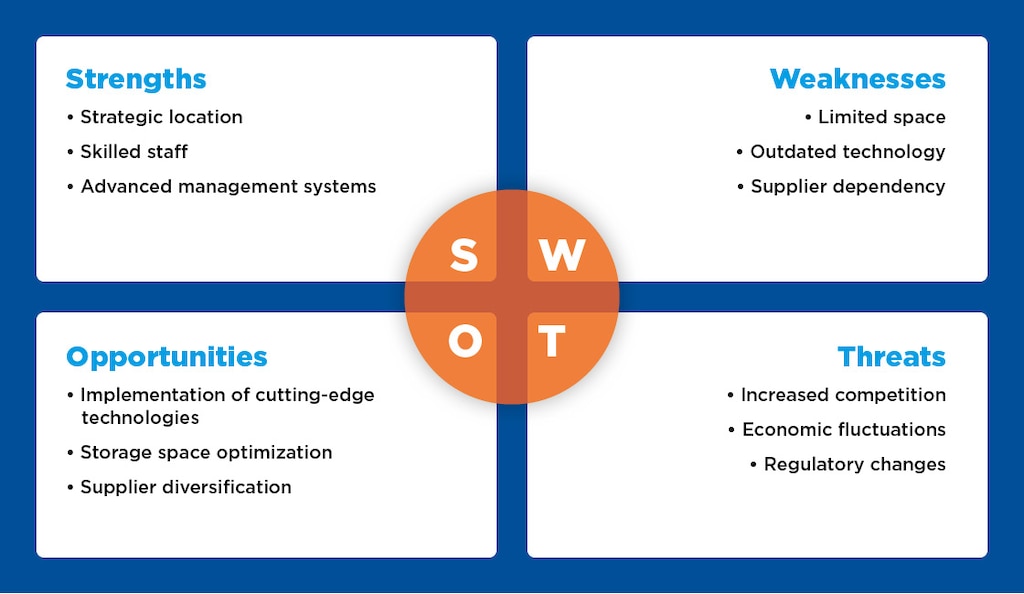
SWOT analysis: definition and how to apply it in logistics
SWOT analysis is a versatile tool used in logistics to identify internal and external factors that could affect the supply chain. To ensure your logistics infrastructure remains competitive, it’s imperative to assess your operational throughput. Then, you can establish guidelines for developing strategies to improve performance and competitiveness.
In this post, we explain how to apply the SWOT analysis in logistics. Weve included a practical example so you can get the most out of the tool, obtaining relevant conclusions to facilitate decision-making.
What is SWOT analysis?
A SWOT analysis is a strategic planning tool widely used in the business and organizational fields. The objectives of SWOT analysis are to evaluate the current situation of a company, project, or context and provide a solid foundation for making significant decisions.
The acronym SWOT stands for these concepts:
- Strengths: internal characteristics that give the company or project a competitive edge. Strengths can encompass resources, highly skilled personnel, advanced technology, a strong brand, or a consolidated customer base.
- Weaknesses: the negative internal characteristics that limit the productivity of an organization or project. Weaknesses can include resource shortages, management issues, a lack of training, and inefficiencies in processes, among other impediments.
- Opportunities: positive external factors that a business exploits to its advantage. These can be market trends, changes in legislation, technological advancements, new market segments, etc.
- Threats: negative external factors that pose challenges or risks to a business or project. Threats can manifest, for example, in the form of aggressive competitors, changes in market conditions, or economic fluctuations.
The purpose of SWOT analysis is to recognize and understand these concepts to help your organization make informed decisions about its strategy. Once you’ve identified the 4 elements, you can employ tactics that leverage your strengths and opportunities, mitigate weaknesses, and address threats.
How to do a SWOT analysis
Conducting a good SWOT analysis involves a structured process to determine and appraise the strengths, weaknesses, opportunities, and threats pertaining to your company or project. These are the 10 steps to follow:
- Define the objective of the analysis. Before beginning, it’s crucial to specify the purpose of your SWOT analysis. Do you want to evaluate your business, a project, a product, or a specific situation?
- Gather information. Collect relevant data on the entity or situation being analyzed. This may include financial reports, market data, management reports, customer feedback, and internal assessments, among other resources.
- Identify strengths. List the positive internal characteristics of the company or situation in question. It’s advisable to consult individuals involved in the process to ascertain the entity’s advantages and assets.
- Detect weaknesses. To pinpoint weaknesses and deficiencies, create a list of negative internal characteristics or areas in which your organization can improve.
- Determine opportunities. Evaluate external positive factors that could benefit your company.
- Identify threats. Analyze external negative factors or potential risks that could unfavorably affect the business.
- Create a SWOT matrix. Draw a matrix with four sections labeled as strengths, weaknesses, opportunities, and threats. Then, fill in each section with the elements observed in the previous steps.
- Analyze and prioritize. Once the SWOT matrix is completed, analyze the relationships between the different categories. It’s essential to know how to exploit your strengths to leverage opportunities, mitigate weaknesses to avoid threats, and understand how threats can impact weaknesses or strengths.
- Develop strategies. Use the information obtained from the SWOT analysis to design specific strategies and action plans. These strategies should capitalize on strengths, make the most of opportunities, address weaknesses, and protect your company against threats.
- Implement and monitor. Finally, apply the strategies and continuously survey their effectiveness, making adjustments if necessary.

SWOT analysis example in warehousing
Below is an example of how to apply a SWOT analysis in a logistics facility, regardless of sector or products managed:
Weaknesses
- Limited space. Warehouses have limited physical space, which can restrict storage capacity and product management during peak-demand periods.
- Outdated technology. Some of the technological systems used in logistics facilities are outdated, potentially leading to operational inefficiency.
- Supplier dependency. Procurement relies heavily on a small number of providers for certain key materials, heightening the risk of supply disruptions.
Threats
- Increased competition. The emergence of new competitors capable of offering lower prices forces the company to adjust prices or improve the quality of its merchandise.
- Economic fluctuations. Economic shifts can affect the demand for storage and logistics services.
- Regulatory changes. Changes in safety regulations may call for additional investments in staff training.
Strengths
- Strategic location. The warehouse is located in a central logistics area close to major transportation routes and customers, facilitating efficient product distribution.
- Skilled staff. The warehouse operators have accumulated experience in inventory management and logistics operations.
- Advanced management systems. The facility uses a warehouse management system (WMS) that automates stock-level tracking and provides more rigorous and efficient inventory control.
Opportunities
- Implementation of cutting-edge technologies. Investing in more advanced technological solutions — e.g., a state-of-the-art WMS — can enhance operational accuracy and effectiveness.
- Storage space optimization. Consider whether it’s possible to expand the warehouse space or acquire additional locations to meet the growing storage demand.
- Supplier diversification. Seeking and developing relationships with new providers can reduce reliance on a limited number of supply sources.
Based on this SWOT analysis, the business can develop specific warehouse strategies, such as:
- Strength-opportunity (SO). Expand or optimize warehousing space to leverage the growing demand for storage.
- Weakness-opportunity (WO). Invest in updated technology to improve inventory management and operational efficiency.
- Strength-threat (ST). Diversify providers to reduce reliance on a limited number of supply sources and mitigate the risk of disruptions.
- Weakness-threat (WT). Establish contingency plans to address changes in safety regulations and minimize associated risks.

SWOT analysis: a valuable tool for optimizing logistics operations
To thrive in a competitive logistics market, it’s vital to assess the state of your business, both internally and externally. The SWOT analysis is a tactical tool that can help your company enhance its logistics performance. By identifying strengths, weaknesses, opportunities, and threats, your organization can make strategic decisions to improve its position in the market.
SWOT analysis provides a comprehensive view of your current business situation, guiding you towards success. Looking to optimize your logistics processes with state-of-the-art automated storage and management systems? Be sure to get in touch. We’re here to help you modernize your warehouse.
